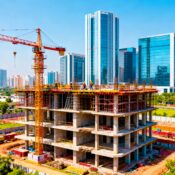
How to Identify High-Growth Areas for Property Investment
Investing in real estate can be highly profitable if you choose the right location. High-growth areas see faster price appreciation and better rental returns. But how do you spot these areas before everyone else?
This guide explains the key factors that signal a location is about to grow in value. By understanding these signs, you can make smarter property investment decisions.
1. Infrastructure Development
Infrastructure projects transform areas by improving connectivity and accessibility. New roads, highways, metro lines, and airports make locations more desirable.
When a place gets better transportation links, more people want to live there. This increases demand for housing, pushing up property prices. Always check government plans for upcoming infrastructure in an area.
Look for projects like new expressways, railway stations, or bridges. Areas near these developments often see rapid growth in the following years. Even announcements of future projects can boost prices early.
2. Government Policies & Initiatives
Government decisions directly impact real estate growth. Special economic zones, smart city projects, and tax benefits attract businesses and residents.
Areas selected for government schemes get better facilities and investments. For example, places designated as industrial hubs or IT corridors see fast development.
Check if an area is part of any special development plans. Also look for policies like relaxed construction rules or subsidies for buyers. These make the location more attractive for investment.
3. Job Opportunities & Commercial Growth
Where jobs go, people follow. Locations with growing businesses and employment opportunities see rising housing demand.
Look for new office parks, tech campuses, or industrial zones. Areas near business districts often become housing hotspots for workers. More jobs mean more people need homes, driving up prices.
Also check if major companies are moving into the area. Corporate expansions usually lead to real estate growth in surrounding neighborhoods.
4. Price Appreciation History

Past performance often indicates future potential. Areas with steady price growth over 5-10 years tend to continue appreciating.
Study historical price trends to spot consistent growth patterns. Locations that have outperformed nearby areas are likely good bets. Avoid places where prices have stagnated or dropped.
Look for areas where prices are rising faster than the city average. This shows strong demand that will likely continue.
5. Social Infrastructure Development
Good schools, hospitals, and shopping centers make an area livable. As these facilities improve, more families want to move in.
Check for new educational institutes, healthcare centers, and retail malls. Areas getting these amenities usually see property value increases.
Planned developments like universities or medical hubs are especially valuable. They create long-term demand from students, staff, and patients.
6. Builder Activity & New Projects
Developers invest heavily in research before launching projects. Where major builders are buying land, growth usually follows.
Track where reputable developers are starting new projects. Large-scale residential or commercial developments signal confidence in an area’s future.
Be cautious of areas with too many stalled projects. Focus on locations where multiple builders are actively constructing quality properties.
7. Rental Demand & Occupancy Rates
Strong rental markets indicate healthy demand. Areas with high occupancy rates and rising rents often see price growth too.
Look for locations where properties rent quickly. Check if rental yields are above the city average. High demand from tenants suggests the area is desirable.
Areas near colleges, business parks, or transit hubs usually have good rental potential. This makes them safer investment bets.
8. Affordability Compared to Nearby Areas
Often, growth spreads from expensive areas to more affordable neighboring locations. These adjacent areas offer good upside potential.
Identify quality locations next to established expensive areas. As the premium areas become unaffordable, demand spills over to these nearby zones.
Look for places with similar advantages but lower prices. As infrastructure improves, these areas often catch up in value.
Key Takeaways for Investors
✔ Focus on areas with planned infrastructure improvements
✔ Follow government development plans and policies
✔ Track job growth and commercial expansions
✔ Study price trends over several years
✔ Look for improving social infrastructure
✔ Watch where reputable builders are investing
✔ Check rental market strength
✔ Consider affordable areas near expensive locations
By carefully analyzing these factors, you can identify high-growth areas before prices peak. Always research thoroughly and consult local experts before investing.
Remember, the best investment opportunities often come from spotting growth trends early. With the right approach, you can find locations poised for significant appreciation.



